
Martin County is a county located in the southeastern part of the state of Florida, in the United States. As of the 2020 census, the population was 158,431. Its county seat is Stuart. Martin County is in the Port St. Lucie, FL Metropolitan Statistical Area.
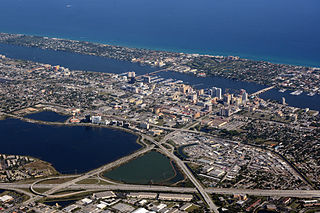
Palm Beach County is a county in the southeastern part of Florida, located in the Miami metropolitan area. It is Florida's third-most populous county after Miami-Dade County and Broward County and the 26th-most populous in the United States, with 1,492,191 residents as of the 2020 census. Its county seat and largest city is West Palm Beach, which had a population of 117,415 as of 2020. Named after one of its oldest settlements, Palm Beach, the county was established in 1909, after being split from Miami -Dade County. The county's modern-day boundaries were established in 1963.

Boynton Beach is a city in Palm Beach County, Florida, United States. It is situated about 57 miles (92 km) north of Miami. The 2020 census recorded a population of 80,380. Boynton Beach is located in the Miami metropolitan area, which was home to 6,138,333 people at the 2020 census. The city is named after Nathan Boynton, a Civil War major and Michigan politician who became one of the first settlers in the area in 1895. Boynton Beach is located north of Delray Beach, south of Hypoluxo and Lantana, and east of Golf, while the municipalities of Briny Breezes, Gulf Stream, Manalapan, and Ocean Ridge are situated to the east across the Intracoastal Waterway.

Lake Worth Beach, previously named Lake Worth, is a city in east-central Palm Beach County, Florida, United States, located about 64 miles (103 km) north of Miami. The city's name is derived from the body of water along its eastern border known as the Lake Worth Lagoon, which was named for General William J. Worth, who led United States Army forces during the last part of the Second Seminole War. Lake Worth Beach is situated south of West Palm Beach, southeast of Lake Clarke Shores, east of Palm Springs, and north of Lantana, while a small section of the city also partitions the town of Palm Beach. The 2010 census recorded a population of 34,910, which increased to 42,219 in the 2020 census. Lake Worth Beach is within the Miami metropolitan area, which was home to an estimated 6,138,333 people in 2020.

Palm Beach is an incorporated town in Palm Beach County, Florida, United States. Located on a barrier island in east-central Palm Beach County, the town is separated from West Palm Beach and Lake Worth Beach by the Intracoastal Waterway to its west and a small section of the Intracoastal Waterway and South Palm Beach to its south. It is part of the South Florida metropolitan area. As of the 2020 census, Palm Beach had a year-round population of 9,245.

West Palm Beach is a city in and the county seat of Palm Beach County, Florida, United States. It is located immediately to the west of the adjacent Palm Beach, which is situated on a barrier island across the Lake Worth Lagoon.
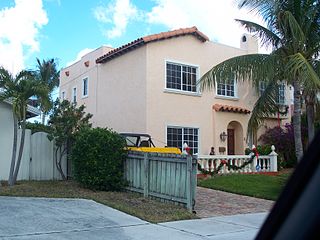
The College Park Historic District is a U.S. historic district located in Lake Worth Beach, Florida. The district is bounded by Maryland Drive, North Federal Highway, 19th Avenue North, and North Dixie Highway. It contains 90 historic buildings and residences.
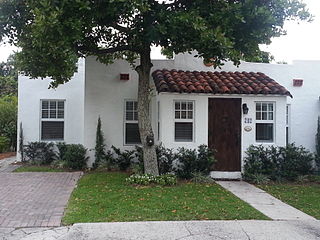
The Grandview Heights Historic District is a U.S. historic district located in West Palm Beach, Florida. The district is bounded by Park Place, Alabama Avenue, M Street, and Lake Avenue.

The Historic Old Town Commercial District is a U.S. historic district located in Lake Worth Beach, Florida. The district is bounded by FEC, M Street, Lucerne Avenue, and 1st Avenue S. It contains 46 historic buildings.
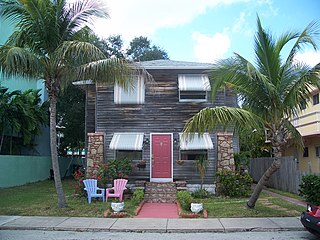
The Old Lucerne Historic Residential District is a U.S. historic district located in Lake Worth Beach, Florida. The district runs roughly along North Lakeside Drive, North Palmway Street, and North O Street, from Lake Avenue to 7th Avenue N. It contains 218 historic buildings.
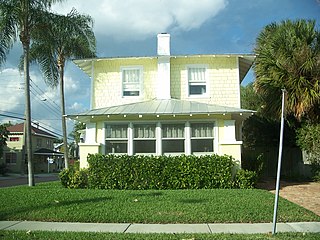
The Mango Promenade Historic District is a U.S. historic district located in West Palm Beach, Florida. The district is bounded by South Dixie Highway, Austin Lane, Coconut Lane, and Cranesnest Way. It contains 125 historic buildings.

The Dixie Crystal Theatre is a historic site in Clewiston, Hendry County, Florida. It is located at 100 East Sugarland Highway. It first opened in 1941. In 1998, it was added to the U.S. National Register of Historic Places.

The Schoolhouse Children's Museum & Learning Center is located in a historic school building, the Boynton School, at 129 East Ocean Avenue in Boynton Beach, Palm Beach County, Florida.

The Boca Raton Old City Hall is a historic site in Boca Raton, Florida, United States. It is located at 71 North Federal Highway. The former city hall now houses the Boca Raton Welcome Center and the Boca Raton History Museum. On October 16, 1980, it was added to the U.S. National Register of Historic Places. The original design was by Addison Mizner. On April 18, 2012, the AIA's Florida Chapter placed it on its list of Florida Architecture: 100 Years. 100 Places as Boca Raton Town Hall.
Frederick H. Trimble was an American architect in Central Florida from the early 1900s through the 1920s. He worked in the Colonial Revival, Spanish Colonial Revival and Prairie Style.
Harvey and Clarke was an American architectural firm formed by Henry Stephen Harvey and L. Philips Clarke in West Palm Beach, Florida, in 1921. The firm was active in South Florida for only a few years, but in that time designed a number of distinctive homes, apartments, churches, and commercial buildings. Harvey was a member of the West Palm Beach Planning Commission. Firm member Gustav Maass designed several railroad stations, and became a noted South Florida architect in his own right.
The history of West Palm Beach, Florida, began more than 5,000 years ago with the arrival of the first aboriginal natives. Native American tribes such as the Jaegas inhabited the area. Though control of Florida changed among Spain, England, the United States, and the Confederate States of America, the area remained largely undeveloped until the 20th century. By the 1870s and 1880s, non-Native American settlers had inhabited areas in the vicinity of West Palm Beach and referred to the settlement as "Lake Worth Country". However, the population remained very small until the arrival of Henry Flagler in the 1890s. Flagler constructed hotels and resorts in Palm Beach to create a travel destination for affluent tourists, who could travel there via his railroad beginning in 1894.
Palm Beach County is a county in the southeastern part of the U.S. state of Florida. Its history dates back to about 12,000 years ago, shortly after when Native Americans migrated into Florida. Juan Ponce de León became the first European in the area, landing at the Jupiter Inlet in 1513. Diseases from Europe, enslavement, and warfare significantly diminished the indigenous population of Florida over the next few centuries. During the Second Seminole War, the Battles of the Loxahatchee occurred west of modern-day Jupiter in 1838. The Jupiter Lighthouse, the county's oldest surviving structure, was completed in 1860. The first homestead claims were filed around Lake Worth in 1873. The county's first hotel, schoolhouse, and railway, the Celestial Railroad, began operating in the 1880s, while the first settlers of modern-day Lake Worth Beach arrived in 1885. During the 1890s, Henry Flagler and his workers constructed the Royal Poinciana Hotel and The Breakers in Palm Beach and extended the Florida East Coast Railway southward to the area. They also developed a separate city for hotel workers, which in 1894 became West Palm Beach, the county's oldest incorporated municipality. Major Nathan Boynton, Congressman William S. Linton, and railroad surveyor Thomas Rickards also arrived in the 1890s and developed communities that became Boynton Beach, Delray Beach, and Boca Raton, respectively.

The Espanola Schoolhouse is a one-story; one-room rural school building that has survived from the Jim Crow racial segregation-era. It is the last standing one-room schoolhouse in Flagler County. It is located at 98 Knox Jones Avenue, Bunnell, Florida 32110.

















